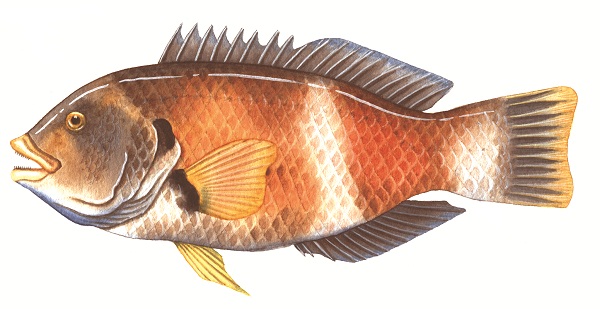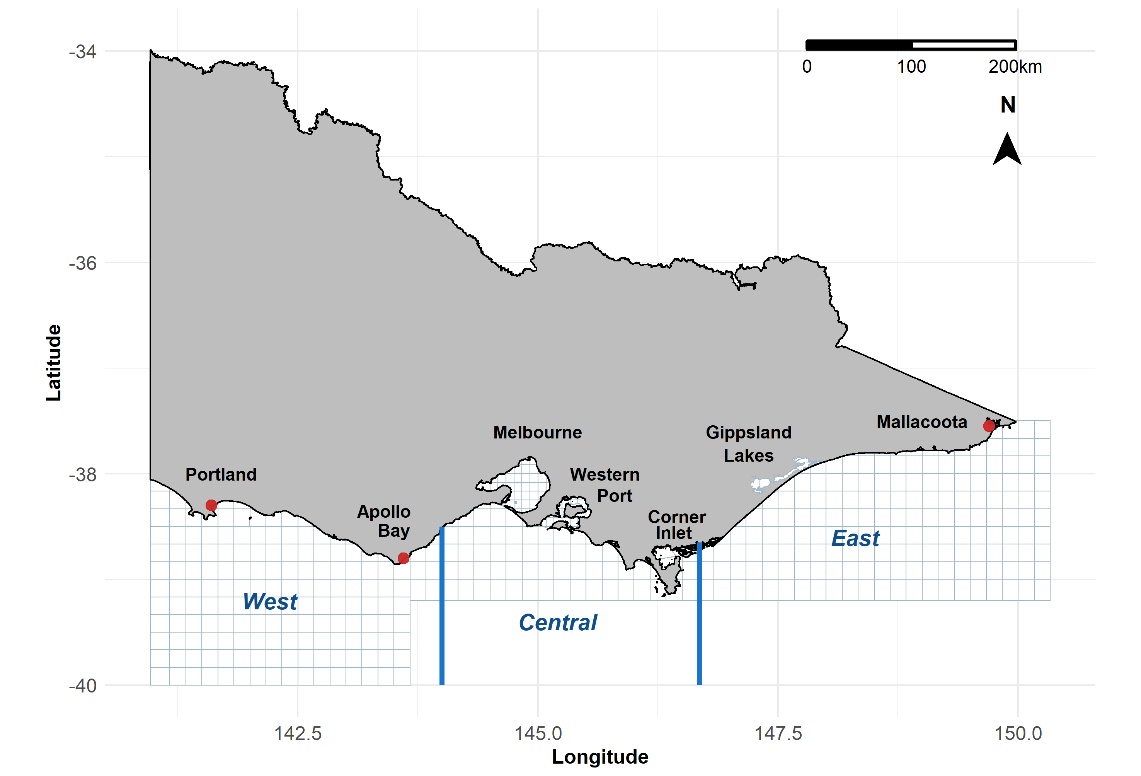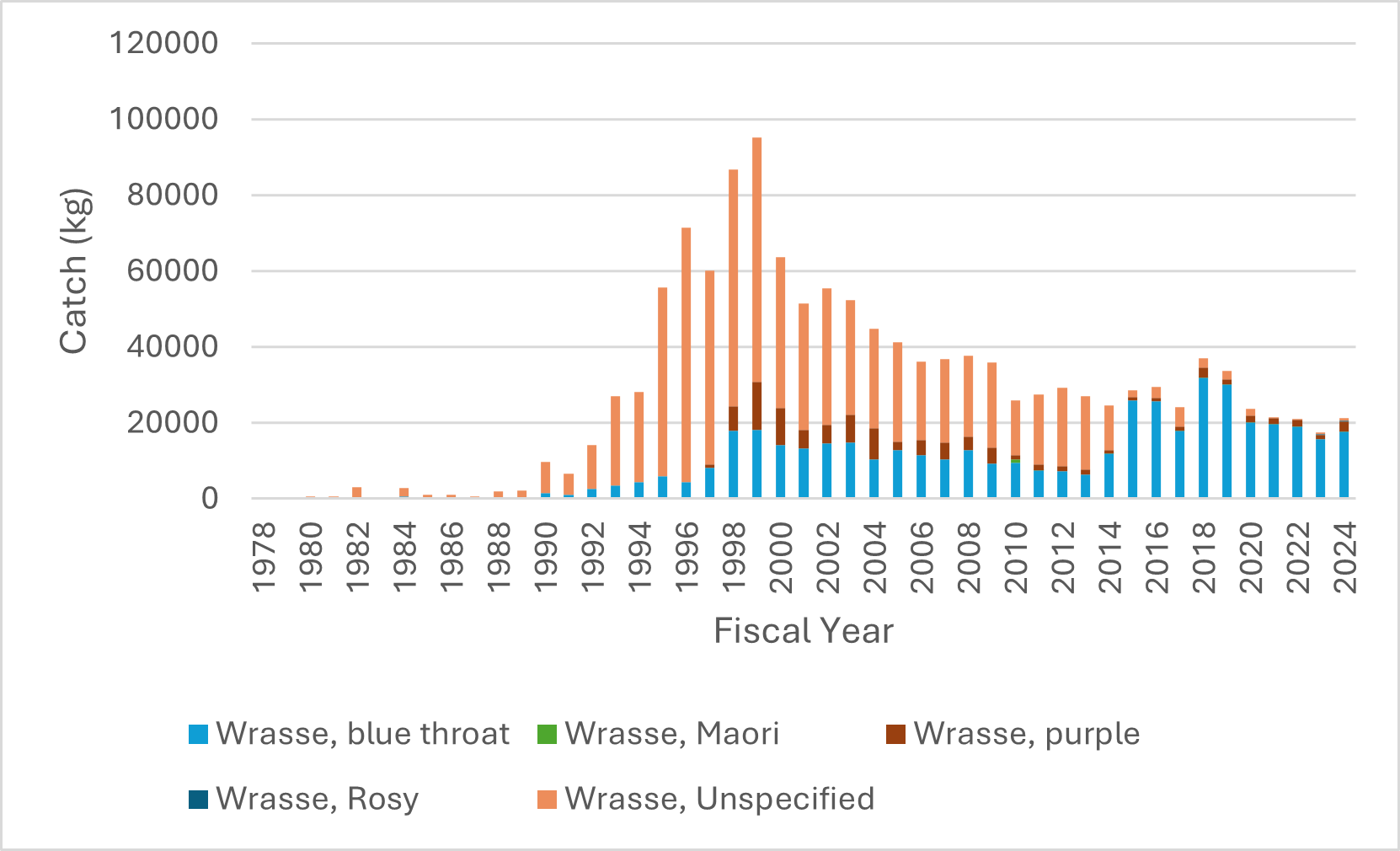Wrasse Fishery
The Victorian Wrasse (Ocean) Fishery was established in the 1990s when a domestic market based on live trade to restaurants and seafood outlets was created.

The fishery extends along the entire length of the Victorian coastline and out to 20 nautical miles offshore, except for marine reserves. The fishery is divided into three commercial management zones; licence holders can fish in any of these zones.
Most wrasse is harvested by hook and line, although commercial rock lobster fishers who also hold a commercial wrasse licence can keep those fish that they catch in their rock lobster pots.

Bluethroat Wrasse (Notolabrus tetricus) and Purple Wrasse, also called Saddled Wrasse (N. fucicola), comprise approximately 90 per cent of the commercial Victorian wrasse harvest.
Small catches of Rosy Wrasse (Pseudolabrus psittaculus), Senator Wrasse (Pictilabrus laticlavius) and Southern Maori Wrasse (Ophthalmolepis lineolatus) are also caught.
Approximately nine per cent of the commercial wrasse harvest is taken in rock lobster pots.
Wrasse biology
There are several biological characteristics of Victorian commercial wrasse that are relevant to sustainable harvest:
- they are relatively long lived;
- they have a long larval period which provides the potential for widespread dispersal;
- females mature below the legal minimum length
- individuals tend to remain close to a home reef and are territorial;
- for Bluethroat Wrasse, reef-based groups are generally comprised of a larger male and a harem of smaller females;
- Bluethroat Wrasse all develop as females and some change to males to replace the dominant males removed from the reef;
- wrasse inhabit reefs that are often deeper than the depths at which commercial fishers target them.
Bluethroat Wrasse can attain a total length of up to 50 centimetres and live for up to 23 years; females mostly mature at about 5 to 8 years of age and at about two thirds their maximum size. Males can reach at least 50 cm total length and mature at approximately 8 years age.
Wrasse inhabit depths up to 160 metres. Bluethroat Wrasse is a hermaphroditic species in that females at some point in their lives, transition to male. This species does not migrate extensively among reefs and the males exhibit territorial behaviour whilst guarding their female harem against competing males.
Purple Wrasse attain a maximum size of 45 centimetres, and for Victorian populations may live at least 16 years, and are found at depths up to 90 metres. Unlike the Bluethroat Wrasse, sex does not change after maturity which means that the exploitable stock may comprise similar proportions of both sexes.
Wrasse have a relatively long larval period (Bluethroat Wrasse: 44 to 66 days; Purple Wrasse: 40 to 87 days) leading to potentially wide dispersal that can repopulate depleted areas. The two species are thought to interbreed to produce hybrids.
Management of the Ocean Wrasse Fishery
After a rapid rise in catch levels in the 1990s to a peak of just under 90 tonnes in 1998/99, catches stabilised to between 40 and 50 tonnes during the period of 2000 to 2004. With the decrease in effort as a result of fewer licences, catches declined to below 30 tonnes. With the introduction of licence transferability in 2017, there has been an increase in total catch in 2017/18 as new licence owners became active in the fishery.
The commercial wrasse fishery is managed primarily by input (i.e. effort) controls:
Limited entry
- There are currently 22 Wrasse (Ocean) Fishery Access Licences (OWFAL) issued under the Fisheries Act 1995;
Legal minimum size
- Bluethroat Wrasse must be at least 30 centimetres total length;
- All other species must be at least 27 centimetres; and
Gear restrictions
- Fishers can use no more than six fishing lines at any one time;
- Each line must not have more than three hooks or one jig attached;
- Longlines are not permitted.
The OWFAL is a transferable licence class. Licences can be sold, bequeathed, or operated by a person other than the licence holder).
Licence holders wishing to permanently transfer their licence to another party must submit a completed Form 19 Transfer Fishery Licence to the Victorian Fisheries Authority.
Form 19 - Application for transfer of a Fishery Licence ![]() [MS Word Document - 510.0 KB]
[MS Word Document - 510.0 KB]
Harvest strategy
Harvest strategies provide formal and structured frameworks that guide fishery management decision-making and assist in achieving management objectives. They bring together the key elements and management functions used to make decisions about the level of fishing activity that should be applied to a fish stock or a management unit to maximise the likelihood of achieving ecological, economic and social sustainability.
The Harvest Strategy for the Victorian Wrasse (Ocean) Fishery was developed when the licences became transferable in 2017.
Harvest Strategy ![]() [MS Word Document - 1.1 MB]
[MS Word Document - 1.1 MB]
Harvest strategy performance update
The available information for the Victorian commercial wrasse fishery indicates that –
- For 2021/22, the primary catch per unit effort (CPUE) performance indicator was above the trigger reference point for the West zone and slightly below for the Central zone.The East zone could not be assessed as no wrasse were landed.
- Around 3% of wrasse were taken in rock lobster pots, well below the 10% allocation permitted under the harvest strategy, as has been the case for seven years.
- In 2021/22,99% of the total wrasse catch was taken by OWFAL holders, consistently increasing from below 50% prior to 2014/15.
- Discard rates were relatively high overall, with about half those caught being discarded Discard rates can give us an indication of the numbers of females in the wrasse population and the total population because wrasse are hermaphrodites, with females transitioning to males later in life. This means the majority of undersized fish are females and there are less males in the wrasse population. Bluethroat wrasse discards were particularly high in the Central and East zones, averaging 67% across years, whereas in the West zone the average was 16%. Rates of Bluethroat discarding were consistent among years within each assessment zone. Purple wrasse discards were less consistent but much lower than for Bluethroat, being less than 10% in most years but with higher rates approaching 40% in 2020 and 2022 in the West zone, where catches of purple wrasse are higher. The total catch for 2021/22 of 21 t was similar to 2020/21 (21.5 t) but down by about one-third from 2018/19 (31.5 t) and 2017/18 (32.6 t) likely due to changed market conditions. This state-wide reduction was driven by a 16% decrease in the Central zone and no landings were reported for the East zone, whereas in the West zone catch increased by 39%.
- In comparison to the relatively stable CPUE trend during the harvest strategy reference period of 2004/05–2014/15, ‘hook & line’ effort increased to a much greater extent than catch reflecting a decrease CPUE i.e. stock biomass until licence transferability in 2017/18. Following transferability both variables have been relatively stable with moderate increases in CPUE apparent over the past two years in the West zone and an increase in the East zone until 2020/21 (no fishing in 2021/22), whereas there has been a decline in the Central zone.
- Monthly patterns of catch and effort since early 2020 have generally been consistent with presumed effects of public restrictions imposed in response to the COVID-19 outbreak in Victoria, associated market conditions, international market constraints on rock lobster exports, and weather patterns, with the influence of these factors on fishing inseparable.
- Recent patterns in effort among different fishing methods are consistent with the introduction of licence transferability as new operators have become active using ‘hook & line’ since 2017/18.
- There has been a demographic shift in ownership of ocean wrasse fishery licences reflected in a recent increase in the proportion of catch taken from the West assessment zone.
The cross-jurisdictional 2018 Status of Australian Fish Stocks determined that the Victorian Bluethroat Wrasse stock is sustainable.
2021/22 Harvest strategy performance update ![]() [PDF File - 1.1 MB]
[PDF File - 1.1 MB]

